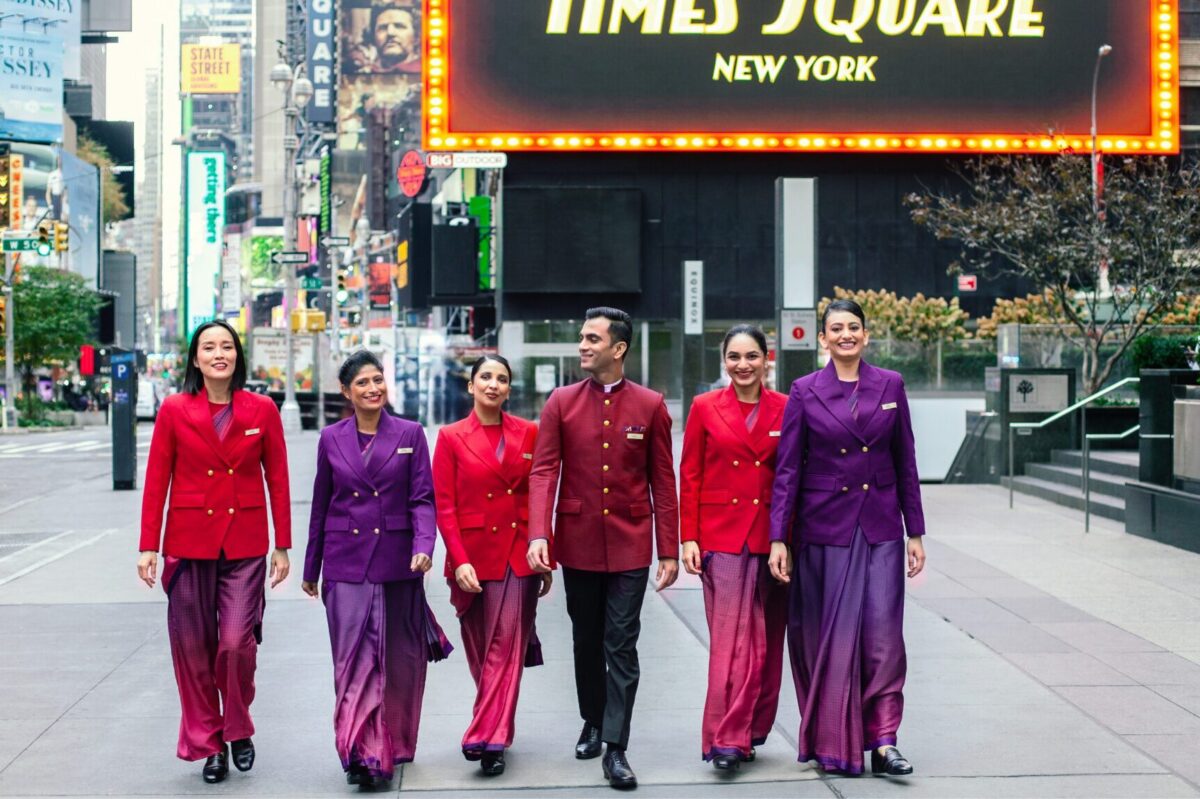Analyzing China’s Travel Reopening, Exactly A Year In

Skift Take

Skift Podcast
Compelling discussions with travel industry leaders and creatives who are helping to shape the future of travel.It’s one of the biggest questions in global tourism: What the hell is happening to tourism from China? It’s a question a lot of us tried to answer throughout 2023 after China reopened – on January 8 – after 3 years of lockdown.
We turned to Gary Bowerman, the founder of Check-in Asia, to help our thinking. He’s been in Asia as a travel analyst, has written books about the Chinese traveler and has been writing a newsletter about the Asia travel economy during Covid and post-Covid.
Below are highlights from the conversation with Bowerman and Skift founder and CEO Rafat Ali. You can hear the full interview here.
Listen Now
Subscribe
Apple Podcasts | Spotify | Overcast | Pocket Casts | Google Podcasts | Amazon | RSS
Host: Rafat Ali
Guest: Gary Bowerman
Producer: Jose Marmolejos
What Is the State of Chinese Tourism?
Bowerman: A year ago, when China reopened the 8th of January, expectations were really, really high that automatically we’d press and play and go back to the 2019 levels when China was the dominant figure in travel and tourism. That hasn’t happened. But we’ve seen gradual growth through the year.
And I think right now at the beginning of 2024, if you talk to people in the Chinese travel industry, there is a much greater sense of optimism that 2024 will be a stronger year. There were so many factors that were limiting growth last year.
Geopolitics and the Impact on Tourism
Bowerman: You can’t divorce Chinese tourism from trade and diplomacy. And the Chinese government has been very clear about this. In 2017, 2018, 2019, [China] had the world’s largest outbound market, and it was prepared to use that in leverage in trade discussions, in diplomacy, not just in Asia-Pacific, although specifically in Asia-Pacific, but also worldwide.
So that’s really where we were at as the gates came down for Covid-19. You had this world’s largest outbound market and China was really using this in trade and diplomacy. When the gates started to come up a year ago, China was very, very wary to not allow Chinese travelers to go out all at once, because it realized that demand would be quite low. The aviation industry, the OTAs in China weren’t ready either.
So it wanted to phase this back across the year. And by doing that, by phasing it back across the year, allowing countries worldwide on a phased basis beginning in February, then March and then August to accept group travel … that then opened up the gates to start negotiating on things like visas, as we’ve seen in recent weeks.
But also on trade policy, China right now has a lot that it wants to sell to the world in travel and tourism. It wants to sell its high-speed rail technology, it wants to sell its new passenger jets.
And so as we start to see China unroll this tourism policy, it will be ever more closely linked to travel and trade. And I think what we’re seeing right now, when you messaged me, we were talking about inbound and how China’s offered these incentives, visa-free travel to what it started with six countries. Now it’s loosening the ties with Thailand, the U.S., Singapore.
This is a sense of realpolitik, I think. How the world has changed since Covid. As you said, trying to realize it couldn’t just use as leverage its outbound market anymore. It has to look at all different aspects of inbound, outbound and trade policy as well.
Why Is There an Increased Emphasis on Inbound Travel?
Bowerman: Primarily the inbound market was seen as the business traveler market, the bleisure market, people who go into China to do business, taking extra time at conferences, trade meetings, that kind of thing, and then spending more time. And also I think China is very much seen as a destination that you either want to go to or you don’t want to go to.
There were a lot of perceptions about what China is about, as you know, in the Western world. So the inbound market was never really focused (on) by the Chinese government too much.
And one of the reasons for that is the cost of a visa was quite expensive to get into China. It’s quite bureaucratic to get a visa.
I think what’s changed now is that China actually has enshrined in its latest five-year policy of the government that it wants to boost inbound tourism. It wants to focus more on the three pillars of travel and tourism. So inbound domestic – the domestic market is booming, it’s really, really strong right now –and the outbound market.
And I think it realizes that this is the way the world thinks now. It can’t really just leverage its outbound market. It needs to have all three pillars to present a different face to China in the world. As you said, the world has changed. Perceptions of China probably got a little bit darker, particularly in the Western world.
And this is China opening up and showing its face as not just a tourism, but as a lifestyle, a technology. People that go to China will see that China has changed a great deal in the past five years, in particular over the last three as well.
The Visa Waiver Strategy
Bowerman: The first six countries that were announced on visa waiver for a year was Malaysia, which is an Asian country. Malaysia quickly reciprocated and waived its fees of Chinese travelers and then five countries in Europe, which are Schengen countries.
But one of the issues over the past year, particularly Chinese outbound travel … is the backlog for Schengen visas and how long it’s taken for Chinese to get visas. And limits are being reached. So a lot of Chinese travelers couldn’t go to Europe this year. So you wonder, really, whether this was a push towards the lead nations of Schengen to actually shake up their policy.
And Chinese media has called this very specifically a unilateral policy: ‘China is showing its benevolent face that you can come to our country without a visa. As of yet, we can’t come to your countries without a visa.’
That’s a year pilot scheme. But then you look at some of the other countries that it’s cherry picking in Southeast Asia – Singapore. Thailand has just been announced in the last couple of days and the timing is going to be a permanent visa waiver in both directions. Singapore looks like that will happen as well next year. … I don’t think there’ll be across-the-board policies.
Risks of a Slowing Chinese Economy
Bowerman: One of the reasons that the domestic tourism economy has been booming is that most of the airlines are flying domestically. I think it’s only about 7% of air capacity in China is international at the moment, 93% of (it is) domestic. And it’s a huge air market. It’s the world’s second-largest air market after the United States.
So at the moment, there’s a lot of opportunities to fly within the country. And also the high-speed rail network became hugely popular during the pandemic. You know, it’s nationwide. It’s the world’s largest, and it’s very easy to travel now. So those two are having a big impact on the supply and are helping travelers to travel.
I think in terms of the outbound market, why is it being so strong this year and why is international being relatively weak? I think there’s a number of reasons. The slowing economy, that’s for sure an impact.
Youth unemployment is very, very high, reaching around 21% in June, to the point where the Chinese government actually stopped publishing the official data.
So the economy has impacted younger people who are travelers. Definitely. The tech economy has slowed down. A lot of the big tech companies have shed a lot of staff over the past three years. That’s a big factor as well.
But I think there’s also (that) Asia-Pacific approached Covid and experienced Covid very differently to the West. It’s taken a lot longer for Asia-Pacific to to regain its confidence.
Hotel Growth Market in China
Bowerman: I think the pipelines are strongly reactivating. Some of the international chains are reactivating their pipelines. The Chinese brands as well.
That is growing and that pipeline is moving into the third-tier cities and fourth-tier cities. A lot of the major cities, they’re quite saturated now across all brands.
And there is a lot of capacity in some of the third- and fourth-tier cities, and that’s where we’ll see growth over the next few years. Demand is there. I think that’s one thing that’s been proven during the pandemic is demand from travelers in lower-tier Chinese cities really, really grew. And that’s where the (online travel agencies) and the Chinese hoteliers really focused a lot of their marketing during the pandemic because they wanted to grow their base.
They all had to turn inwards. They couldn’t look at outbound travel for three years, so they had to turn inwards and they had to build new, new capacity in their customer bases. And that was in the lower-tier cities.
Will In-Bound Business Travel Recover?
Bowerman: So what happened as soon as China reopened, the leading executives of pretty much all companies around the world rushed to China to reanimate their relationships. You’ve seen that throughout the year. The business travelers from major companies have been in and out of China. And it’s reanimating a lot of its conferences and its tech sector.
And its meetings and incentives business. But the world has changed since Covid. You know, India is a much stronger player. Vietnam is a strong player now. Indonesia is emerging as a very, very strong economy in Southeast Asia. So we are going to see over the next decade, the next 20 years, China’s dominance of the region will probably still be there because it is the major player, the superpower.
But you will see much more pocketing of outsourcing around the world. In the U.S. you’ve got a lot of “backsourcing.” The whole trade landscape of Asia is changing. But the growth is there and the growth for Asia’s economies going forward will be generated mostly within Asia. And the dynamics of that will come from India and China.
Demographic Shifts
Bowerman: Japan, Korea and Singapore also is aging very, very fast. And if you look at the actual projection curve for the Chinese population over the next sort of 50, 60 years, it is going to contract quite significantly.
But it also has a huge population of young people. And at the moment, if you’re looking at a lot of the trends that are happening, the new trends that are happening domestically in terms of consumers and also travelers, that’s being driven by the post-nineties and also the post-2000 generation. They don’t tend to talk about millennials or Gen Z, they tend to post in terms of decade periods.
So things like home rentals is very, very strong in China at the moment. A lot of that has been driven by younger people. Car rental is exactly the same, that’s absolutely flying and that’s younger people as well.
Look at the high-speed rail. The interesting thing about high-speed rail in China is that it’s become not just about traveling from A to B, the actual travel on board has become an experience.
It’s hard to overstate just how important Chinese social media is for all aspects of consumerism, particularly travel. And that’s true worldwide. I accept that. But the Chinese social media ecosystem hides behind a wall, and the rest of the world doesn’t know so much about it.
It has its own dynamics and I think that’s one of the things we’ve probably learned this year across the world, is that to really, really engage Chinese travelers going forward, you have to understand Chinese social media and the different dynamics between the different platforms.
What Does it Mean to Be ‘China Ready’ Now?
Bowerman: One thing that I’ve always been saying all year is rethink absolutely everything.
I think you have to be prepared for the fact that younger Chinese travelers are very discerning. They have high expectations because hotel standards, airline standards, high-speed rail train standards in China are high now. They’re not coming to Europe and to the U.S. being surprised by the level of standards.
Quite the opposite.
So you’ve got to over-perform and you really have to look at how they use social media because that’s changing all the time.
I read a lot of articles on the top 10 social media trends of 2024. That’s the top 10 trends right now. But those will change in 10 days, 20 days, 30 days.
You have to keep an eye on the ball about how Chinese consumers are changing, because I would say this and this is quite a contentious issue, but I think Chinese consumers are the most indulged technologically in the world and that influences their expectations.





